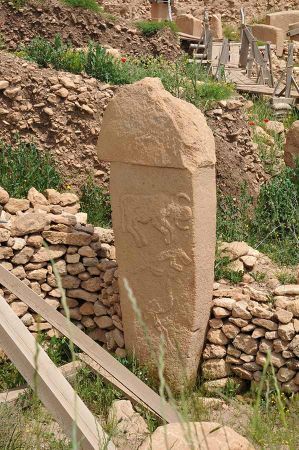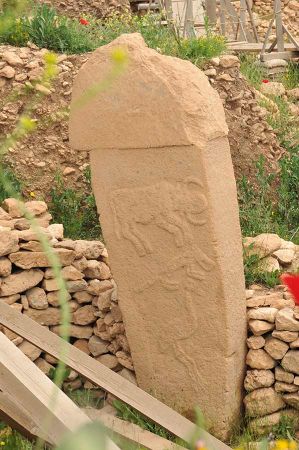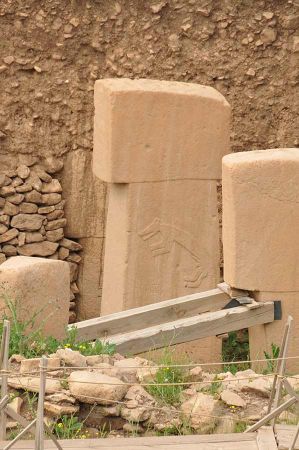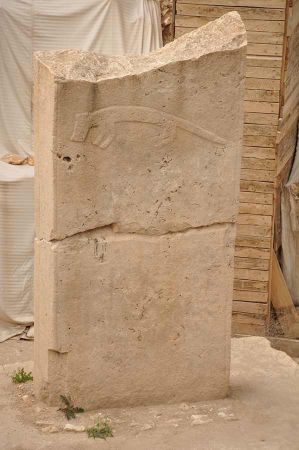Symbols of sanctuary Göbekli Tepe the first characters?
- Written by Portal Editor
For thousands of years, people have been communicating through language, passing on knowledge and techniques through oral transmission of what they have learned, with all the erroneous distortions of meaning by omitting or adding details of the original content.
Psychological, social and cultural factors in the human environment inevitably always play an important role in oral tradition. Information important for survival, which has a similar core, but also secret knowledge, rituals, myths, legends and legends were passed on orally around the world, although their details can vary considerably. Even today there are cultures in which the oral transmission of traditions and knowledge is quite common.
Olmecs are associated with the use of writing
 The invention of writing is considered one of the most important achievements of human civilization, as it was the first time that knowledge and cultural traditions could be reliably transmitted across generations and guaranteed their preservation (depending on the quality of the inscribed material and of course the circumstances) over a long period of time. All known early civilizations such as the Sumerians and Egyptians, the Indus cultures, the Middle Kingdom and the Olmec are associated with the use of writing. But how did writing come about?
The invention of writing is considered one of the most important achievements of human civilization, as it was the first time that knowledge and cultural traditions could be reliably transmitted across generations and guaranteed their preservation (depending on the quality of the inscribed material and of course the circumstances) over a long period of time. All known early civilizations such as the Sumerians and Egyptians, the Indus cultures, the Middle Kingdom and the Olmec are associated with the use of writing. But how did writing come about?
Many millennia ago, Ice Age hunters left behind their living environment in the form of cave paintings in which the animal world but also the hunt itself was depicted. How and when the first symbols and then characters developed from such concrete images is still a matter of scientific debate. Perhaps a solution to the existing questions can now be found in the unique monuments of the stone columns of Göbekli Tepe, an excavation site by the unfortunately recently deceased archaeologist Klaus Schmidt near the Turkish city of Sanliurfa. For years, Schmidt had led excavations there at man-made "burial mounds" that unearthed the pillar-like columns from around 12,000 years ago. The abundant animal images and symbols of the Stone Age sanctuary Göbekli Tepe indicate the first known change to symbolic interpretation: scriptural precursors from 12,000 years ago.
 The stone circles of Göbekli Tepe are characterized by large, T-shaped, rectangular pillars made of limestone. On the surfaces of these T-pillars there are animals depicted in bas relief, including snakes, scorpions, foxes, cranes, gazelles and wild asses. There are also more abstract symbols such as animals, hands or the combination of moon disk and crescent moon. According to Ludwig Morenz from the Department of Egyptology at the University of Bonn, it is precisely these signs that indicate that Stone Age people must have taken the first steps towards writing.
The stone circles of Göbekli Tepe are characterized by large, T-shaped, rectangular pillars made of limestone. On the surfaces of these T-pillars there are animals depicted in bas relief, including snakes, scorpions, foxes, cranes, gazelles and wild asses. There are also more abstract symbols such as animals, hands or the combination of moon disk and crescent moon. According to Ludwig Morenz from the Department of Egyptology at the University of Bonn, it is precisely these signs that indicate that Stone Age people must have taken the first steps towards writing.
The archaeologist Ludwig Morenz sees in the imagery of Göbekli Tepe clear indications of an incipient abstraction and thus the beginning of a symbolic coding - more than 5,000 years before the first Egyptian hieroglyphs.
“The high-altitude sanctuary is something like the missing link between images and the first characters,” says Ludwig Morenz. "Göbekli Tepe stands for the development of pure images to encode meaning that goes beyond this." While the depiction of a bull in the cave of Altamira in Spain is a direct image of the animal, a bull's head in the high-altitude sanctuary in Turkey is to be understood as an abstract symbol for a deity, detached from the primary meaning of the image. These almost abstract animal figures could be a first step towards writing.
Abstracted images as symbols
 The symbols could have several meanings at the same time: On the one hand, a snake represents a threat, but can also be understood as a sign of something absent - because the snake's imprint remains in the sand long after the animal has moved on. The image of an abstracted hand can be interpreted as a gesture - for example of defence. “It’s a leap into a new media world,” says Morenz. In his opinion, the animal images from Göbekli Tepe were already used as such symbols.
The symbols could have several meanings at the same time: On the one hand, a snake represents a threat, but can also be understood as a sign of something absent - because the snake's imprint remains in the sand long after the animal has moved on. The image of an abstracted hand can be interpreted as a gesture - for example of defence. “It’s a leap into a new media world,” says Morenz. In his opinion, the animal images from Göbekli Tepe were already used as such symbols.
Already at the end of the Ice Age, the foundations were laid on which the later cultural revolution could be built. However: “This early visual language is not yet written characters,” the researcher clarifies. Characters are much more differentiated and also contain information about how a certain character is pronounced. Nevertheless, this early form of pictographs is more than twice as old as the oldest characters of the ancient Egyptians.
Similar symbols elsewhere too
 The Egyptologist supports his thesis with the fact that a total of around 20 different pictographs in a similar form were discovered in other early Neolithic sites within a radius of 150 kilometres around Göbekli Tepe. People settled early in this fertile landscape between the upper reaches of the Euphrates and Tigris. They shared the same symbols with slight variations in the various settlements. “This cannot be a coincidence, the people of this cultural area must have agreed on a uniform symbol system,” Morenz is convinced.
The Egyptologist supports his thesis with the fact that a total of around 20 different pictographs in a similar form were discovered in other early Neolithic sites within a radius of 150 kilometres around Göbekli Tepe. People settled early in this fertile landscape between the upper reaches of the Euphrates and Tigris. They shared the same symbols with slight variations in the various settlements. “This cannot be a coincidence, the people of this cultural area must have agreed on a uniform symbol system,” Morenz is convinced.
According to the researcher, Göbekli Tepe impressively shows how complex and specialized the Stone Age society was around 12,000 years ago. “The use of language, hand and brain went hand in hand,” says Morenz. To the extent that people back then created an abstract visual language with great technical and intellectual skill, they penetrated beyond the challenges of everyday life into religious spheres and confronted humanity's fundamental questions about the afterlife. “It is about the beginning of media development and the departure into new thinking spaces,” says Morenz.
 Traditionally, the Sumerians are cited as the culture in which writing was first used. The oldest written finds probably come from the Uruk site from layers beneath the so-called Uruk III layer. They are therefore dated to the 4th millennium BC.
Traditionally, the Sumerians are cited as the culture in which writing was first used. The oldest written finds probably come from the Uruk site from layers beneath the so-called Uruk III layer. They are therefore dated to the 4th millennium BC.
These are mostly business texts. However, the script used does not allow any conclusions to be drawn about the language, so it is incorrect to describe this script as Sumerian in the strict sense.
Few researchers believe that the symbolic signs of the Vinča culture in southeastern Europe, which dates back to the 5th millennium BC.
It is dated to be an actual writing.
Ähnliche Symbole auch anderswo
 The Egyptian hieroglyphs are often viewed as an idea of characters imported from the Near East; However, recent discoveries by Günter Dreyer in Egypt question this theory and he suspects an independent invention. Writing was also developed independently in China and Central America (Maya). The first known written evidence from Central America is a stone block discovered in Veracruz in which a total of 62 symbols are carved; Some of these signs were also found on finds that researchers attributed to the Olmec culture. It is currently assumed that the twelve-kilogram tablet is around 3,000 years old.
The Egyptian hieroglyphs are often viewed as an idea of characters imported from the Near East; However, recent discoveries by Günter Dreyer in Egypt question this theory and he suspects an independent invention. Writing was also developed independently in China and Central America (Maya). The first known written evidence from Central America is a stone block discovered in Veracruz in which a total of 62 symbols are carved; Some of these signs were also found on finds that researchers attributed to the Olmec culture. It is currently assumed that the twelve-kilogram tablet is around 3,000 years old.
The theory, which is supported by evidence, about the emergence of writing systems in largely geographically separated cultures, is repeatedly countered by individual scientists and private scholars in various variations with the thesis that the oldest known writing systems were developed from an older, partly common, globally widespread character layer. However, no evidence has yet been presented that can withstand scientific criticism.
 The history of writing should not only be seen as a history of the fixation of language. It is to be expected that there is also a separate history of symbols, signs and characters. The writing we know today is preceded by rock carvings, e.g. B. in the Lascaux cave, around 20,000 years ago. Abstract symbols were already used there too, which probably had a magical and symbolic character. People have been using these signs and images to leave messages for tens of thousands of years. However, we can only speak of writing when a defined system of characters is available to express various pieces of information. As early as the Neolithic period, stones with geometric lines were produced, which research can say with some certainty that they were used for counting, probably the most important basis for the development of real writing.
The history of writing should not only be seen as a history of the fixation of language. It is to be expected that there is also a separate history of symbols, signs and characters. The writing we know today is preceded by rock carvings, e.g. B. in the Lascaux cave, around 20,000 years ago. Abstract symbols were already used there too, which probably had a magical and symbolic character. People have been using these signs and images to leave messages for tens of thousands of years. However, we can only speak of writing when a defined system of characters is available to express various pieces of information. As early as the Neolithic period, stones with geometric lines were produced, which research can say with some certainty that they were used for counting, probably the most important basis for the development of real writing.
However, from all the discussions about new discoveries, it becomes clear again and again how little current knowledge about human development actually is.
Please read as well:
The Great Hall of the Historical City Hall of Wuppertal
The Eger Castle - fortification of the town of Cheb
https://www.alaturka.info/en/turkey-country/southeastern/6287-symbols-of-sanctuary-goebekli-tepe-the-first-characters#sigProId7621de1791

